Cross-Cultural Management Report: HR Strategies and Cultural Effects
VerifiedAdded on 2023/01/12
|11
|1305
|70
Report
AI Summary
This report delves into the multifaceted realm of cross-cultural management, examining its profound influence on international business practices and human resource strategies. The analysis centers on Marks & Spencer, comparing its operations in Germany and Brazil to illustrate the varying impacts of societal culture. The report distinguishes between different levels of culture within organizations and identifies the comparative ethical approaches employed. It then applies the role of culture in international business contexts, analyzing how societal culture acts as a contingent factor. Furthermore, the report assesses and leverages the impact of culture on management and other business functions, particularly considering how HR strategies are affected at various levels. The study incorporates Hofstede's cultural dimensions to provide a nuanced understanding of the subject matter and concludes with key insights into the importance of adapting management and HR practices to diverse cultural landscapes. The report also includes relevant references to support its arguments.
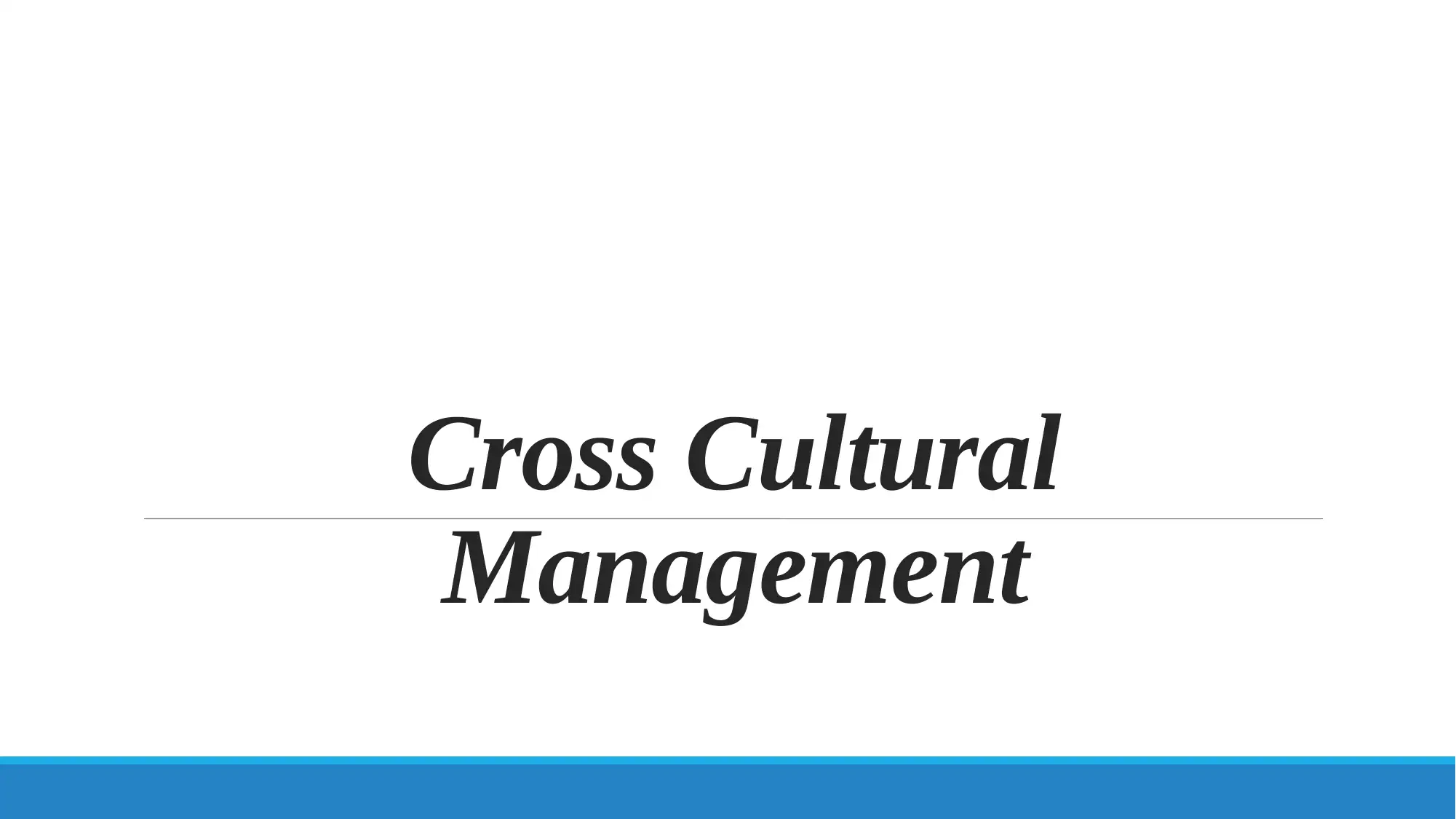
Cross Cultural
Management
Management
Paraphrase This Document
Need a fresh take? Get an instant paraphrase of this document with our AI Paraphraser
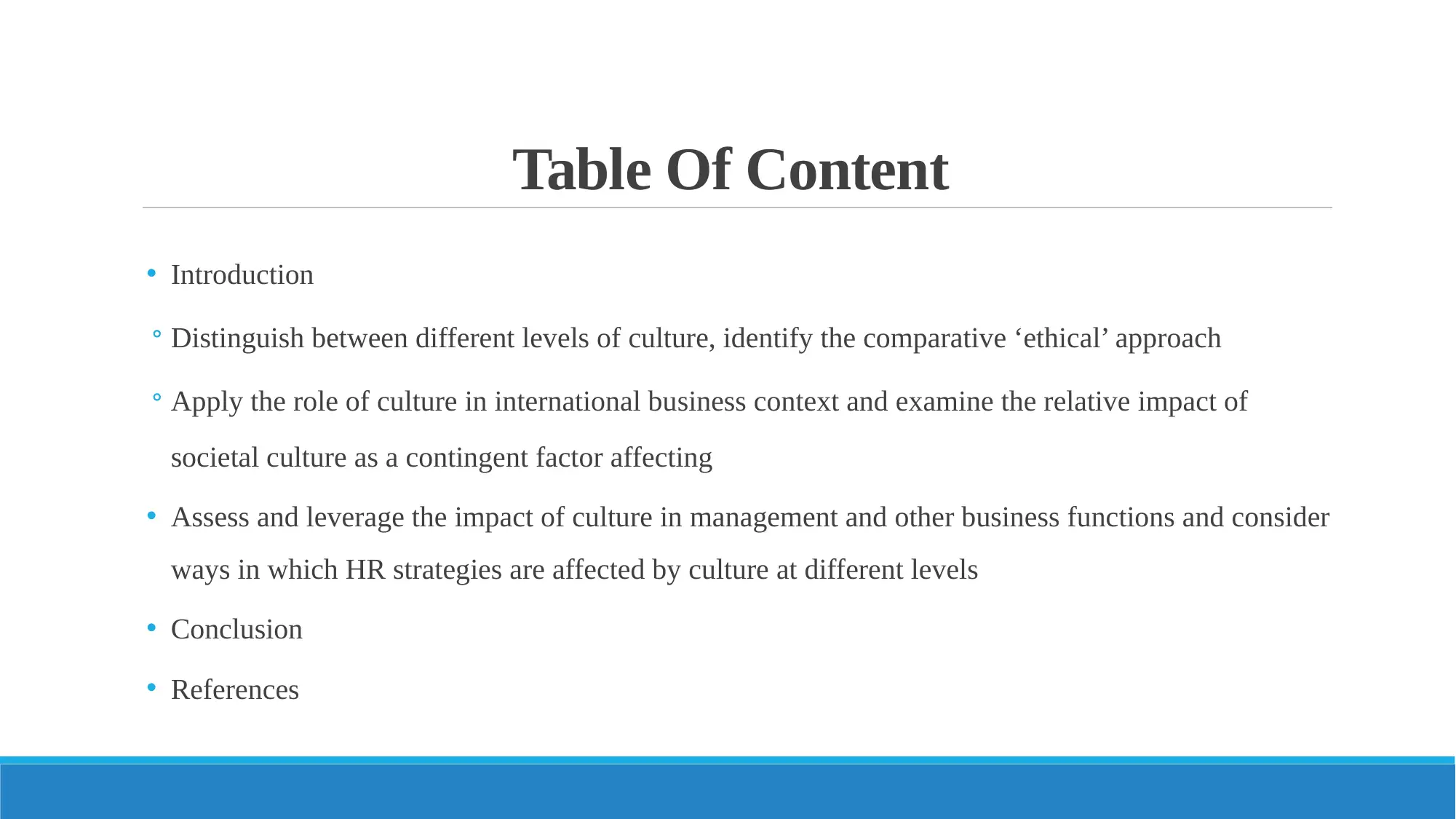
Table Of Content
• Introduction
◦ Distinguish between different levels of culture, identify the comparative ‘ethical’ approach
◦ Apply the role of culture in international business context and examine the relative impact of
societal culture as a contingent factor affecting
• Assess and leverage the impact of culture in management and other business functions and consider
ways in which HR strategies are affected by culture at different levels
• Conclusion
• References
• Introduction
◦ Distinguish between different levels of culture, identify the comparative ‘ethical’ approach
◦ Apply the role of culture in international business context and examine the relative impact of
societal culture as a contingent factor affecting
• Assess and leverage the impact of culture in management and other business functions and consider
ways in which HR strategies are affected by culture at different levels
• Conclusion
• References
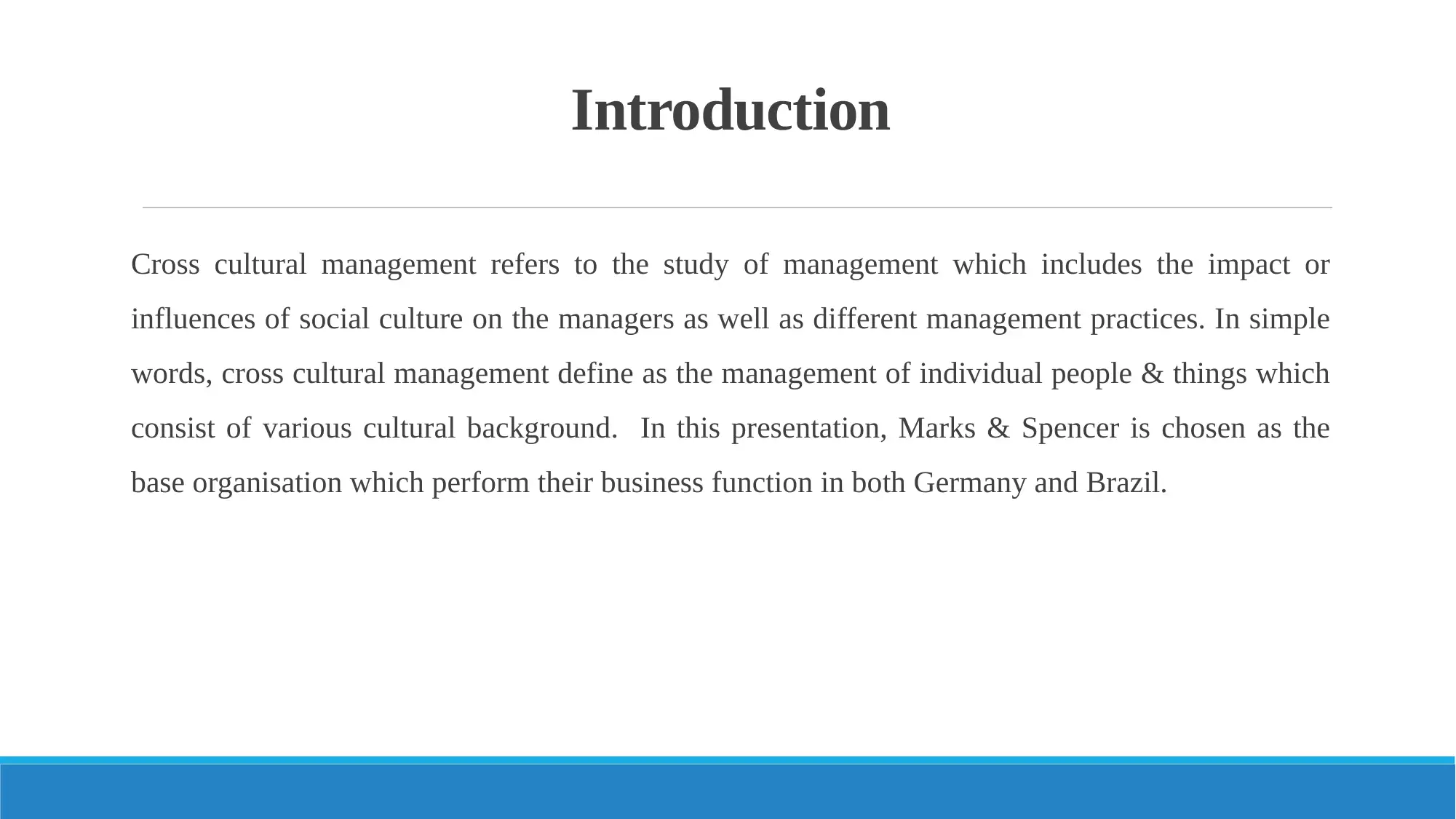
Introduction
Cross cultural management refers to the study of management which includes the impact or
influences of social culture on the managers as well as different management practices. In simple
words, cross cultural management define as the management of individual people & things which
consist of various cultural background. In this presentation, Marks & Spencer is chosen as the
base organisation which perform their business function in both Germany and Brazil.
Cross cultural management refers to the study of management which includes the impact or
influences of social culture on the managers as well as different management practices. In simple
words, cross cultural management define as the management of individual people & things which
consist of various cultural background. In this presentation, Marks & Spencer is chosen as the
base organisation which perform their business function in both Germany and Brazil.
⊘ This is a preview!⊘
Do you want full access?
Subscribe today to unlock all pages.

Trusted by 1+ million students worldwide
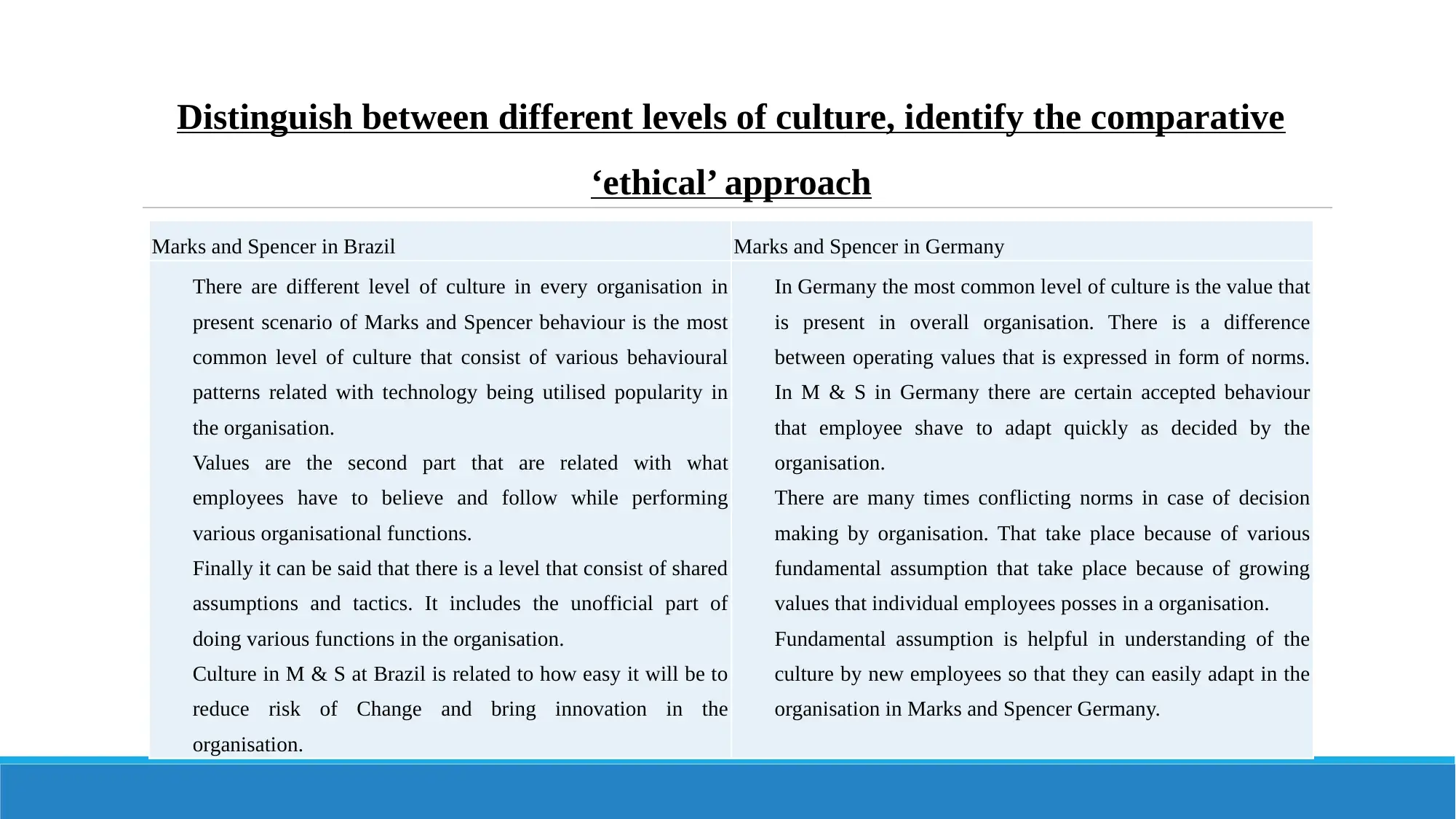
Distinguish between different levels of culture, identify the comparative
‘ethical’ approach
Marks and Spencer in Brazil Marks and Spencer in Germany
There are different level of culture in every organisation in
present scenario of Marks and Spencer behaviour is the most
common level of culture that consist of various behavioural
patterns related with technology being utilised popularity in
the organisation.
Values are the second part that are related with what
employees have to believe and follow while performing
various organisational functions.
Finally it can be said that there is a level that consist of shared
assumptions and tactics. It includes the unofficial part of
doing various functions in the organisation.
Culture in M & S at Brazil is related to how easy it will be to
reduce risk of Change and bring innovation in the
organisation.
In Germany the most common level of culture is the value that
is present in overall organisation. There is a difference
between operating values that is expressed in form of norms.
In M & S in Germany there are certain accepted behaviour
that employee shave to adapt quickly as decided by the
organisation.
There are many times conflicting norms in case of decision
making by organisation. That take place because of various
fundamental assumption that take place because of growing
values that individual employees posses in a organisation.
Fundamental assumption is helpful in understanding of the
culture by new employees so that they can easily adapt in the
organisation in Marks and Spencer Germany.
‘ethical’ approach
Marks and Spencer in Brazil Marks and Spencer in Germany
There are different level of culture in every organisation in
present scenario of Marks and Spencer behaviour is the most
common level of culture that consist of various behavioural
patterns related with technology being utilised popularity in
the organisation.
Values are the second part that are related with what
employees have to believe and follow while performing
various organisational functions.
Finally it can be said that there is a level that consist of shared
assumptions and tactics. It includes the unofficial part of
doing various functions in the organisation.
Culture in M & S at Brazil is related to how easy it will be to
reduce risk of Change and bring innovation in the
organisation.
In Germany the most common level of culture is the value that
is present in overall organisation. There is a difference
between operating values that is expressed in form of norms.
In M & S in Germany there are certain accepted behaviour
that employee shave to adapt quickly as decided by the
organisation.
There are many times conflicting norms in case of decision
making by organisation. That take place because of various
fundamental assumption that take place because of growing
values that individual employees posses in a organisation.
Fundamental assumption is helpful in understanding of the
culture by new employees so that they can easily adapt in the
organisation in Marks and Spencer Germany.
Paraphrase This Document
Need a fresh take? Get an instant paraphrase of this document with our AI Paraphraser
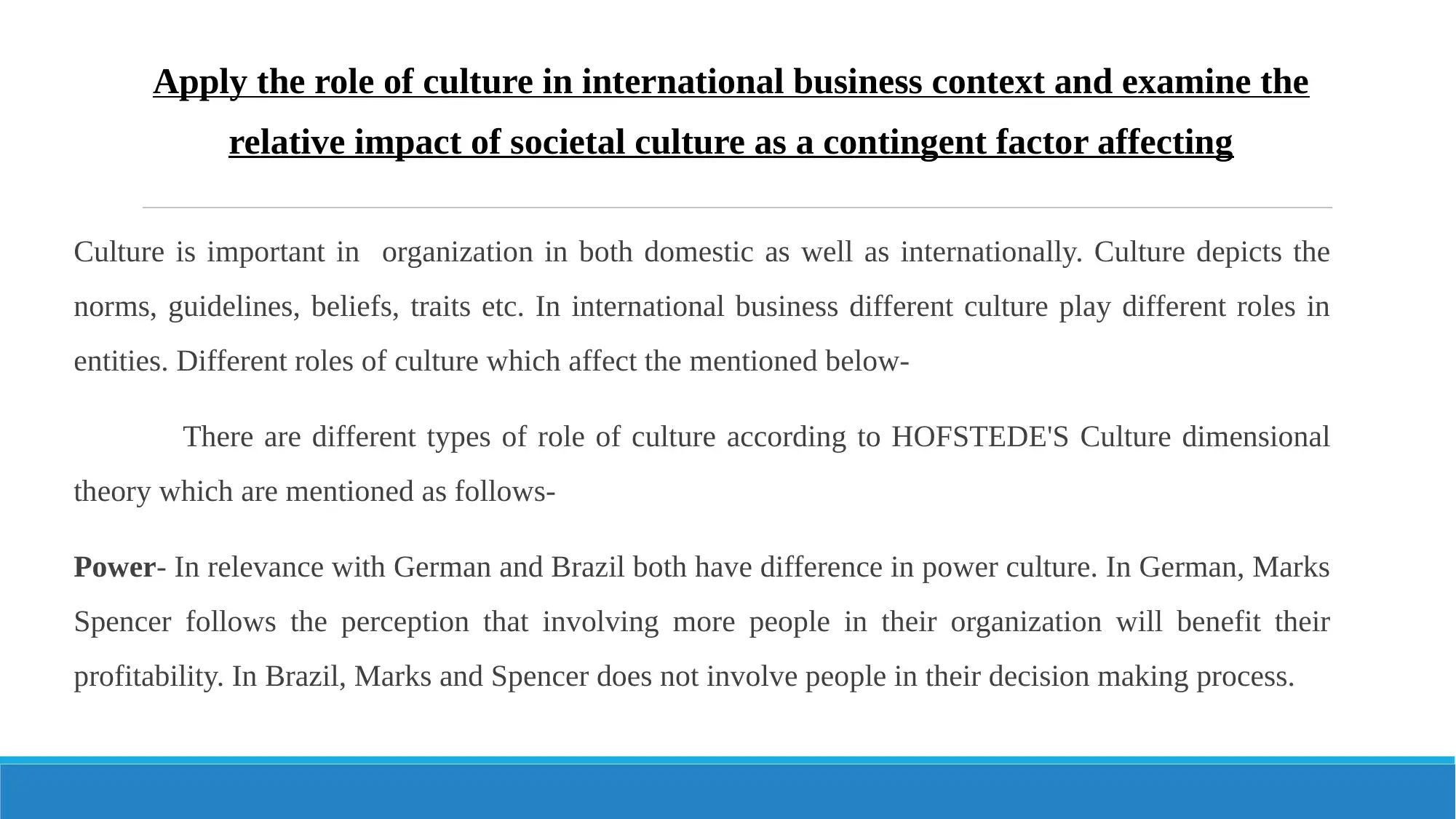
Apply the role of culture in international business context and examine the
relative impact of societal culture as a contingent factor affecting
Culture is important in organization in both domestic as well as internationally. Culture depicts the
norms, guidelines, beliefs, traits etc. In international business different culture play different roles in
entities. Different roles of culture which affect the mentioned below-
There are different types of role of culture according to HOFSTEDE'S Culture dimensional
theory which are mentioned as follows-
Power- In relevance with German and Brazil both have difference in power culture. In German, Marks
Spencer follows the perception that involving more people in their organization will benefit their
profitability. In Brazil, Marks and Spencer does not involve people in their decision making process.
relative impact of societal culture as a contingent factor affecting
Culture is important in organization in both domestic as well as internationally. Culture depicts the
norms, guidelines, beliefs, traits etc. In international business different culture play different roles in
entities. Different roles of culture which affect the mentioned below-
There are different types of role of culture according to HOFSTEDE'S Culture dimensional
theory which are mentioned as follows-
Power- In relevance with German and Brazil both have difference in power culture. In German, Marks
Spencer follows the perception that involving more people in their organization will benefit their
profitability. In Brazil, Marks and Spencer does not involve people in their decision making process.
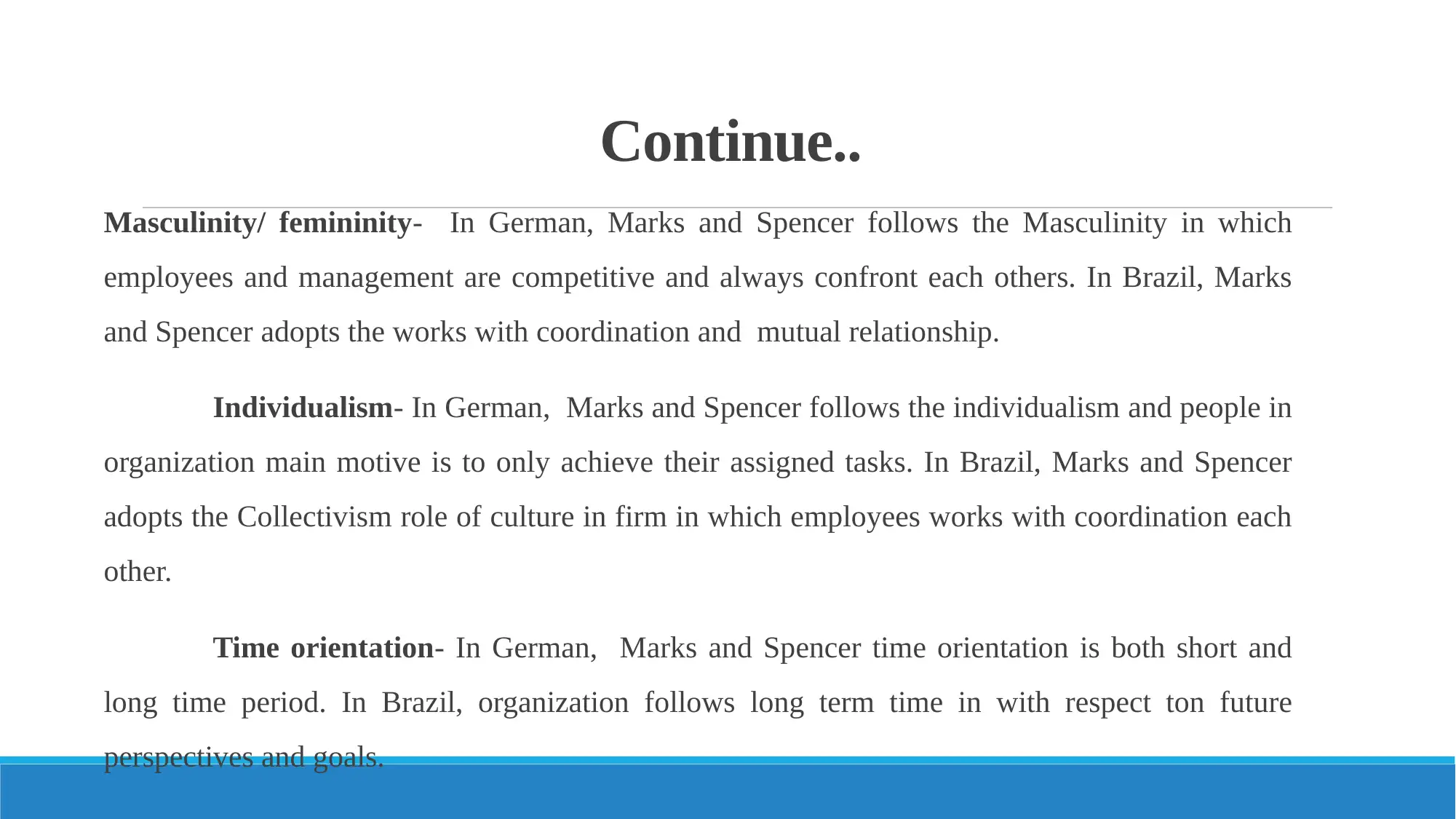
Continue..
Masculinity/ femininity- In German, Marks and Spencer follows the Masculinity in which
employees and management are competitive and always confront each others. In Brazil, Marks
and Spencer adopts the works with coordination and mutual relationship.
Individualism- In German, Marks and Spencer follows the individualism and people in
organization main motive is to only achieve their assigned tasks. In Brazil, Marks and Spencer
adopts the Collectivism role of culture in firm in which employees works with coordination each
other.
Time orientation- In German, Marks and Spencer time orientation is both short and
long time period. In Brazil, organization follows long term time in with respect ton future
perspectives and goals.
Masculinity/ femininity- In German, Marks and Spencer follows the Masculinity in which
employees and management are competitive and always confront each others. In Brazil, Marks
and Spencer adopts the works with coordination and mutual relationship.
Individualism- In German, Marks and Spencer follows the individualism and people in
organization main motive is to only achieve their assigned tasks. In Brazil, Marks and Spencer
adopts the Collectivism role of culture in firm in which employees works with coordination each
other.
Time orientation- In German, Marks and Spencer time orientation is both short and
long time period. In Brazil, organization follows long term time in with respect ton future
perspectives and goals.
⊘ This is a preview!⊘
Do you want full access?
Subscribe today to unlock all pages.

Trusted by 1+ million students worldwide
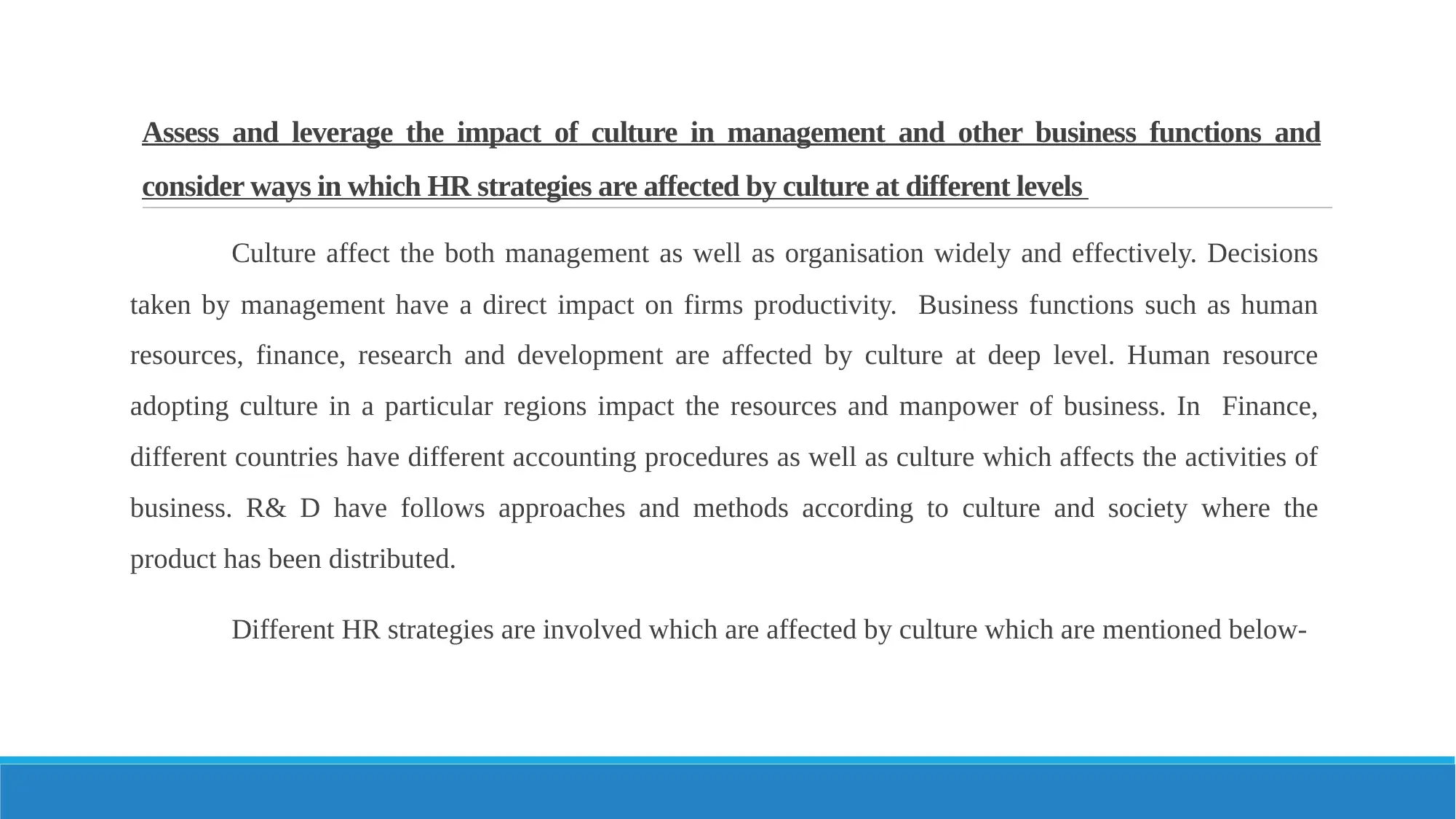
Assess and leverage the impact of culture in management and other business functions and
consider ways in which HR strategies are affected by culture at different levels
Culture affect the both management as well as organisation widely and effectively. Decisions
taken by management have a direct impact on firms productivity. Business functions such as human
resources, finance, research and development are affected by culture at deep level. Human resource
adopting culture in a particular regions impact the resources and manpower of business. In Finance,
different countries have different accounting procedures as well as culture which affects the activities of
business. R& D have follows approaches and methods according to culture and society where the
product has been distributed.
Different HR strategies are involved which are affected by culture which are mentioned below-
consider ways in which HR strategies are affected by culture at different levels
Culture affect the both management as well as organisation widely and effectively. Decisions
taken by management have a direct impact on firms productivity. Business functions such as human
resources, finance, research and development are affected by culture at deep level. Human resource
adopting culture in a particular regions impact the resources and manpower of business. In Finance,
different countries have different accounting procedures as well as culture which affects the activities of
business. R& D have follows approaches and methods according to culture and society where the
product has been distributed.
Different HR strategies are involved which are affected by culture which are mentioned below-
Paraphrase This Document
Need a fresh take? Get an instant paraphrase of this document with our AI Paraphraser
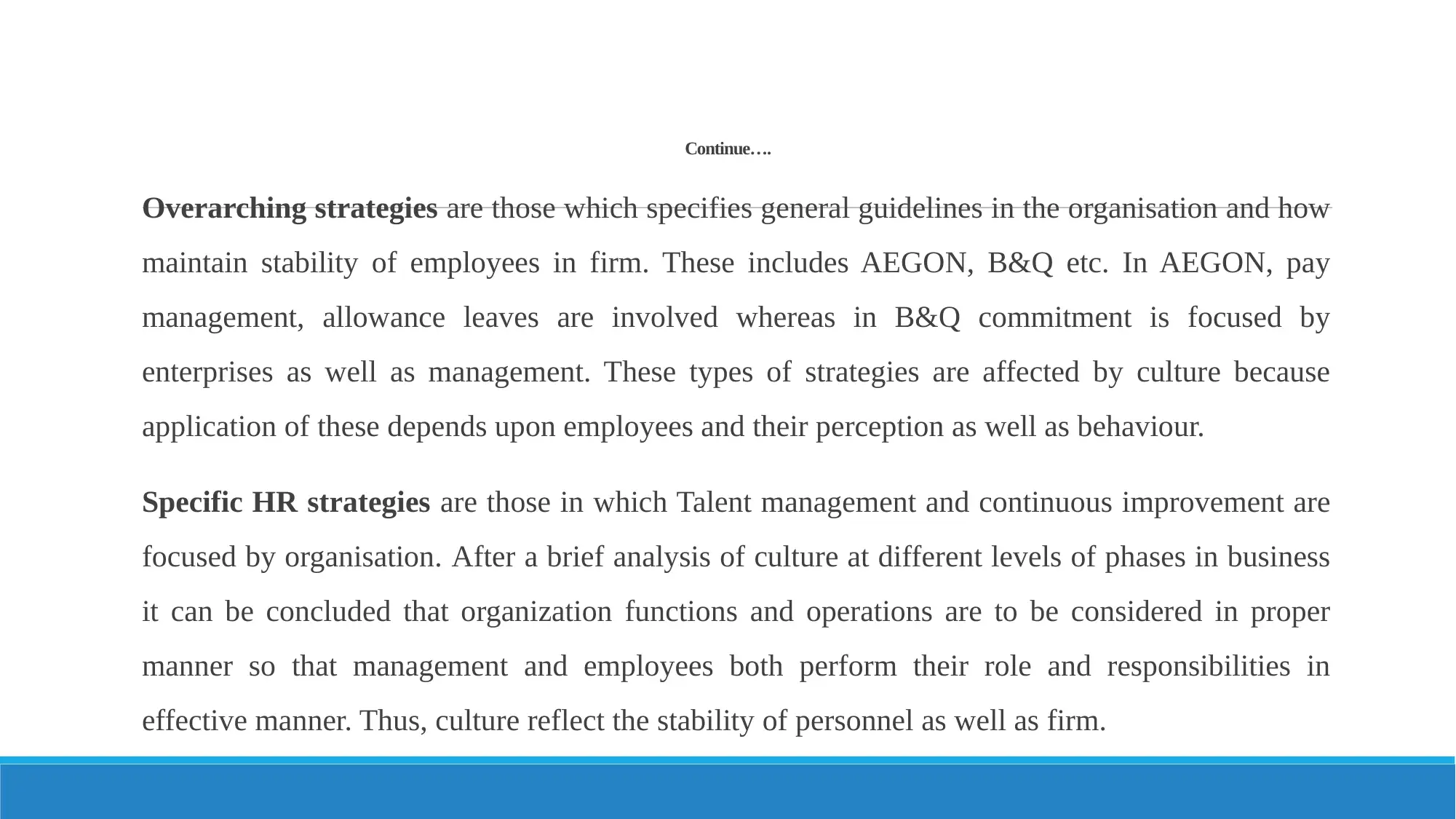
Continue….
Overarching strategies are those which specifies general guidelines in the organisation and how
maintain stability of employees in firm. These includes AEGON, B&Q etc. In AEGON, pay
management, allowance leaves are involved whereas in B&Q commitment is focused by
enterprises as well as management. These types of strategies are affected by culture because
application of these depends upon employees and their perception as well as behaviour.
Specific HR strategies are those in which Talent management and continuous improvement are
focused by organisation. After a brief analysis of culture at different levels of phases in business
it can be concluded that organization functions and operations are to be considered in proper
manner so that management and employees both perform their role and responsibilities in
effective manner. Thus, culture reflect the stability of personnel as well as firm.
Overarching strategies are those which specifies general guidelines in the organisation and how
maintain stability of employees in firm. These includes AEGON, B&Q etc. In AEGON, pay
management, allowance leaves are involved whereas in B&Q commitment is focused by
enterprises as well as management. These types of strategies are affected by culture because
application of these depends upon employees and their perception as well as behaviour.
Specific HR strategies are those in which Talent management and continuous improvement are
focused by organisation. After a brief analysis of culture at different levels of phases in business
it can be concluded that organization functions and operations are to be considered in proper
manner so that management and employees both perform their role and responsibilities in
effective manner. Thus, culture reflect the stability of personnel as well as firm.
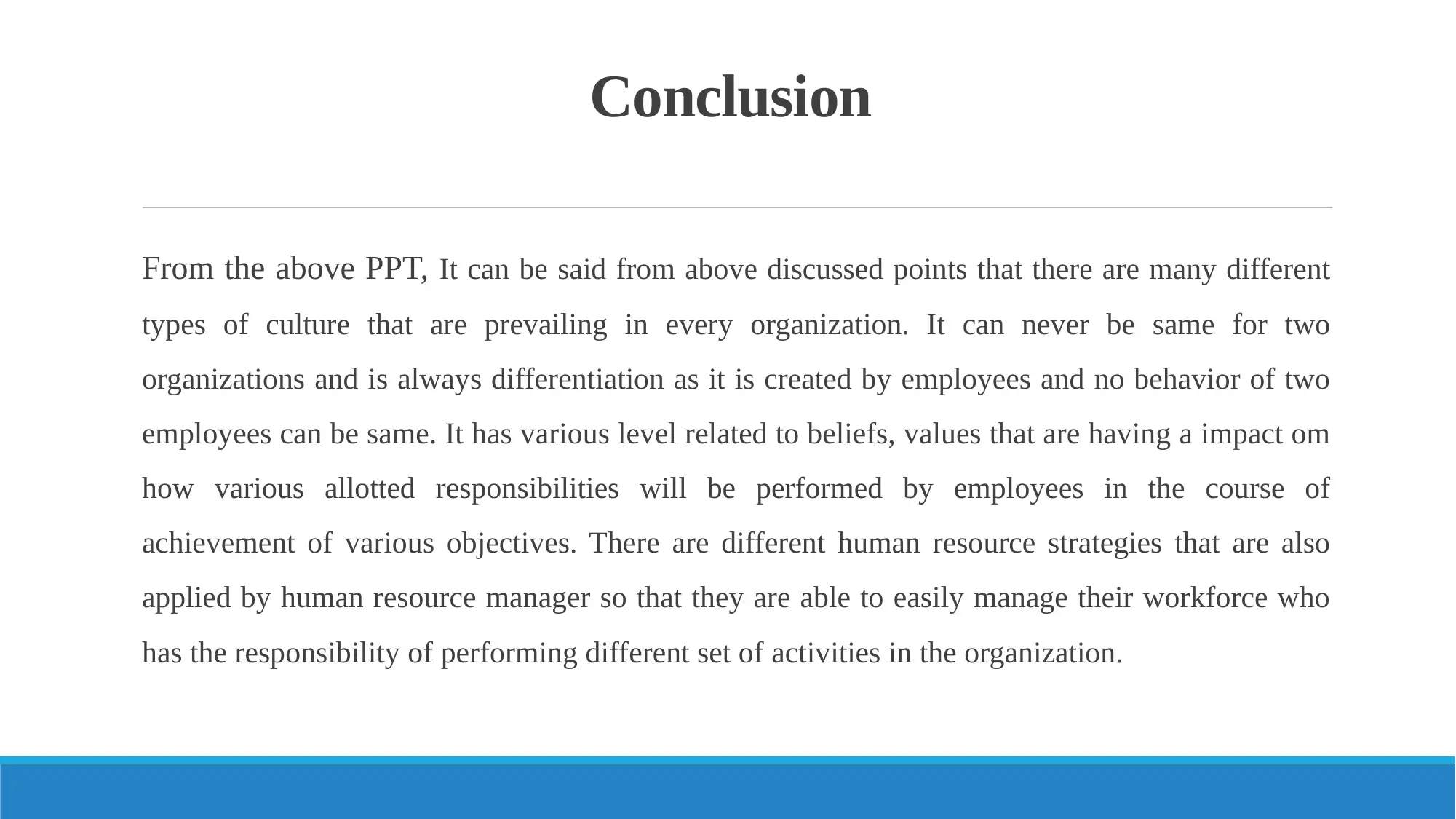
Conclusion
From the above PPT, It can be said from above discussed points that there are many different
types of culture that are prevailing in every organization. It can never be same for two
organizations and is always differentiation as it is created by employees and no behavior of two
employees can be same. It has various level related to beliefs, values that are having a impact om
how various allotted responsibilities will be performed by employees in the course of
achievement of various objectives. There are different human resource strategies that are also
applied by human resource manager so that they are able to easily manage their workforce who
has the responsibility of performing different set of activities in the organization.
From the above PPT, It can be said from above discussed points that there are many different
types of culture that are prevailing in every organization. It can never be same for two
organizations and is always differentiation as it is created by employees and no behavior of two
employees can be same. It has various level related to beliefs, values that are having a impact om
how various allotted responsibilities will be performed by employees in the course of
achievement of various objectives. There are different human resource strategies that are also
applied by human resource manager so that they are able to easily manage their workforce who
has the responsibility of performing different set of activities in the organization.
⊘ This is a preview!⊘
Do you want full access?
Subscribe today to unlock all pages.

Trusted by 1+ million students worldwide
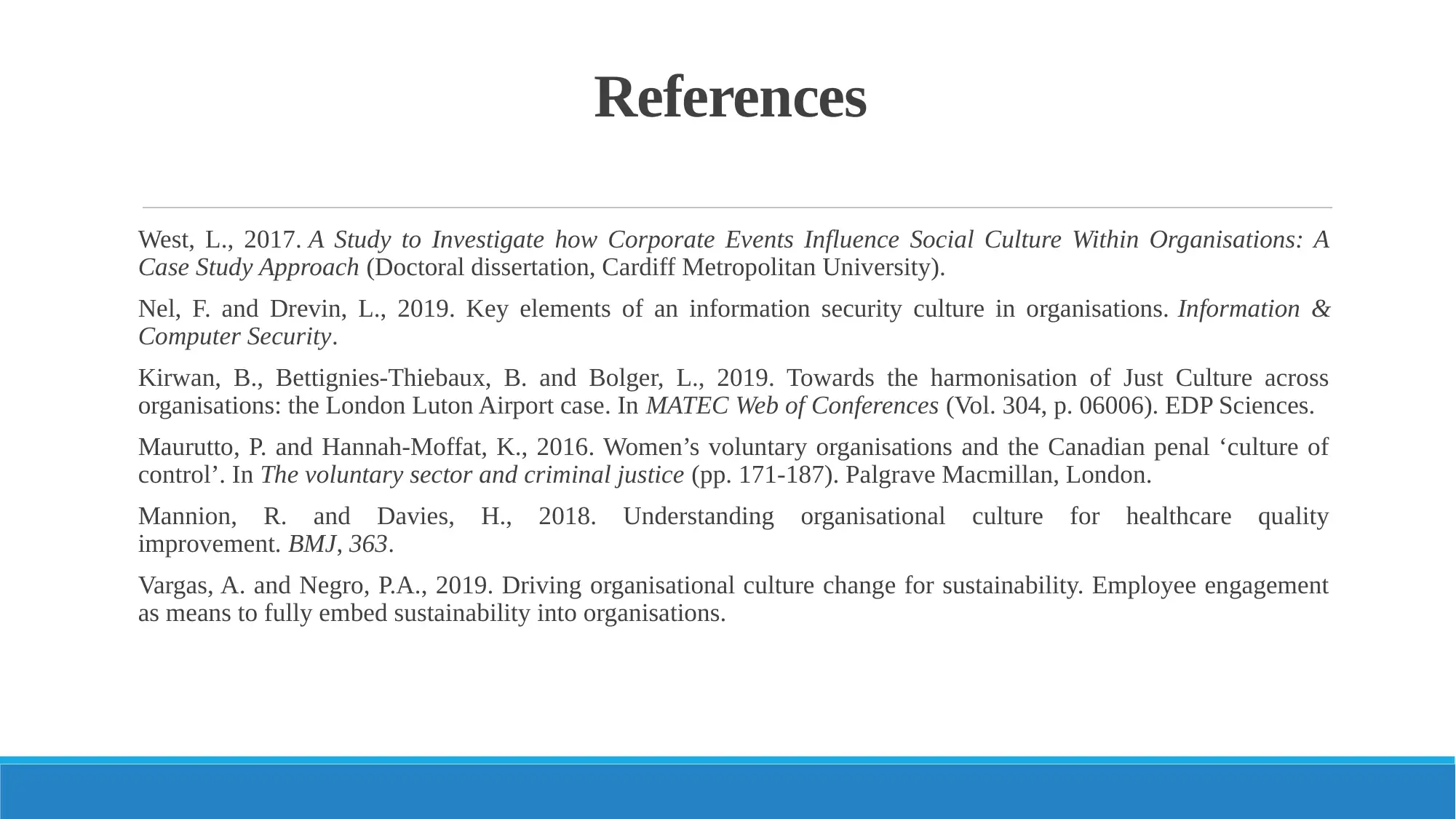
References
West, L., 2017. A Study to Investigate how Corporate Events Influence Social Culture Within Organisations: A
Case Study Approach (Doctoral dissertation, Cardiff Metropolitan University).
Nel, F. and Drevin, L., 2019. Key elements of an information security culture in organisations. Information &
Computer Security.
Kirwan, B., Bettignies-Thiebaux, B. and Bolger, L., 2019. Towards the harmonisation of Just Culture across
organisations: the London Luton Airport case. In MATEC Web of Conferences (Vol. 304, p. 06006). EDP Sciences.
Maurutto, P. and Hannah-Moffat, K., 2016. Women’s voluntary organisations and the Canadian penal ‘culture of
control’. In The voluntary sector and criminal justice (pp. 171-187). Palgrave Macmillan, London.
Mannion, R. and Davies, H., 2018. Understanding organisational culture for healthcare quality
improvement. BMJ, 363.
Vargas, A. and Negro, P.A., 2019. Driving organisational culture change for sustainability. Employee engagement
as means to fully embed sustainability into organisations.
West, L., 2017. A Study to Investigate how Corporate Events Influence Social Culture Within Organisations: A
Case Study Approach (Doctoral dissertation, Cardiff Metropolitan University).
Nel, F. and Drevin, L., 2019. Key elements of an information security culture in organisations. Information &
Computer Security.
Kirwan, B., Bettignies-Thiebaux, B. and Bolger, L., 2019. Towards the harmonisation of Just Culture across
organisations: the London Luton Airport case. In MATEC Web of Conferences (Vol. 304, p. 06006). EDP Sciences.
Maurutto, P. and Hannah-Moffat, K., 2016. Women’s voluntary organisations and the Canadian penal ‘culture of
control’. In The voluntary sector and criminal justice (pp. 171-187). Palgrave Macmillan, London.
Mannion, R. and Davies, H., 2018. Understanding organisational culture for healthcare quality
improvement. BMJ, 363.
Vargas, A. and Negro, P.A., 2019. Driving organisational culture change for sustainability. Employee engagement
as means to fully embed sustainability into organisations.
Paraphrase This Document
Need a fresh take? Get an instant paraphrase of this document with our AI Paraphraser

THANK YOU
1 out of 11
Related Documents
Your All-in-One AI-Powered Toolkit for Academic Success.
+13062052269
info@desklib.com
Available 24*7 on WhatsApp / Email
![[object Object]](/_next/static/media/star-bottom.7253800d.svg)
Unlock your academic potential
Copyright © 2020–2025 A2Z Services. All Rights Reserved. Developed and managed by ZUCOL.





